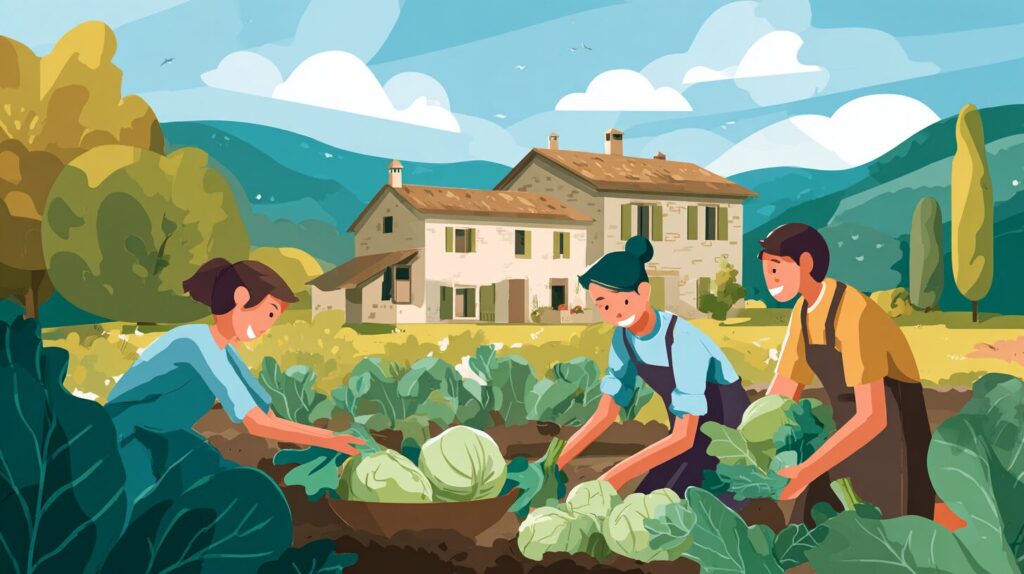サステナブルツーリズムを英語で説明・紹介するための基本情報と、英会話に役立つ表現をシンプルでわかりやすい英語で紹介します。
英会話ダイアローグ・概要・10の質問を通して、サステナブルツーリズムに関する英語表現を学びます。
英語
英会話ダイアローグを読む前に知っておくと良い前提知識と情報です。
- サステナブルツーリズムの基本概念
- 自然環境や地域社会、文化、経済を守りながら行う「持続可能な観光」のこと
- 長期的な持続性を重視し、観光地の自然や文化を保護しながら地域に貢献することを目指す
- 従来の観光との違い
- 従来型観光は大量の観光客が訪れ、地域や環境に負担がかかる場合も多い
- サステナブルツーリズムはその悪影響を減らし、未来へ価値を残すことを重視
- 主な特徴とメリット
- 環境保護、地域社会や文化への配慮、地元経済への貢献が三本柱
- 旅行者にとっても「本物の体験」や「地元の人との交流」ができ、旅の満足度が高まる
- オーバーツーリズムの問題
- 観光地に観光客が過度に集中することで起こる問題
- 交通渋滞、環境破壊、住民生活への悪影響、文化の商業化などが発生
- サステナブルツーリズムはこうした課題を解決するアプローチでもある
- 具体的な取り組み事例
- 最近の人気や動向
- サステナブルツーリズムは世界的に注目されており、日本でも関心が高まりつつある分野
2人がサステナブルツーリズムについて話しています。
環境や地域社会に配慮した旅行のあり方、従来の観光との違い、サステナブルツーリズムの事例やオーバーツーリズムとの関係などを話題にしています。
会話 / dialogue

Hey Key, have you heard much about sustainable tourism lately?

Yeah, I’ve been reading about it quite a bit. Why do you ask?

I’m getting more interested in it. I want to travel in a way that actually helps the places I visit, not harms them.

That’s a great mindset. Sustainable tourism is really about making travel positive for both the environment and the people who live there.

So, what exactly does sustainable tourism mean?

Basically, it means traveling while protecting nature, respecting local culture, and supporting the local economy. It’s the opposite of mass tourism that can cause lots of problems.

Problems like what?

Well, one big issue is overtourism—when too many tourists visit one place. That often leads to crowded streets, more waste, higher prices, and even damage to historical sites and nature.

I’ve seen pictures of places like Kyoto or Venice being completely packed with tourists.

Exactly. Sustainable tourism tries to prevent that by limiting visitor numbers, spreading tourists across more areas, and encouraging better behavior.

I see. So, what are the main features of sustainable tourism?

There are three main points: protecting the environment, respecting local people and culture, and supporting the local economy.

Can you give me an example?

Sure. For example, Yakushima in Kagoshima limits the number of hikers and requires visitors to take their trash home. It helps keep the forests clean and healthy.

That makes sense. Are there any places in Japan doing something similar?

Yes, Shirakawa-go controls tourist numbers to protect its traditional houses. Mt. Fuji now limits the number of climbers and even requires reservations in some seasons.

Wow, I didn’t know that. Are tourists in Japan really interested in sustainable travel?

More and more are, especially visitors from overseas. Surveys show that about 70% of foreign tourists in Japan care about sustainability. It’s not as high for Japanese tourists yet, but interest is growing.

What makes sustainable tourism so appealing, do you think?

I think it’s because you get a more authentic experience—you can join eco-tours, try farm stays, and connect with locals. Plus, it feels good to know your trip is helping, not hurting.

I like that idea. I’ve always wanted to try staying at a farm and help with local activities.

That’s a perfect example. Farm stays are popular sustainable options. You help the community, learn new things, and enjoy nature.

Does it help with environmental problems too?

Absolutely. Sustainable tourism means using less plastic, saving energy, and following rules that protect local wildlife and plants.

It sounds like it’s good for everyone—locals, travelers, and the environment.

That’s the point. If more people choose sustainable tourism, we can keep our favorite places beautiful for future generations.

Thanks, Key. I’m inspired. Next trip, I’ll definitely look for sustainable options!
概要(サステナブルツーリズムの特徴と事例)
「サステナブルツーリズム」について、理解を深めるための「英語での概要」です。
サステナブルツーリズム

What Is Sustainable Tourism?
Sustainable tourism means traveling in a way that is good for the environment, people, and local culture. The goal is to enjoy travel without hurting nature or local communities. Sustainable tourism tries to make sure that beautiful places, animals, and cultures stay safe for many years. It is different from traditional tourism, which can sometimes cause problems like too many tourists or damage to nature.
Main Features of Sustainable Tourism
There are three important parts of sustainable tourism. First, it protects the environment. Tourists are careful not to leave trash, use less plastic, and save water and energy. Second, it respects local people and their traditions. Tourists learn about local customs and behave politely. Third, sustainable tourism supports the local economy. It is good to stay in local hotels, eat local food, and buy souvenirs from local shops.
Why Sustainable Tourism Is Important
Sustainable tourism is important because it helps everyone. It keeps nature and culture safe for the future. Local people get more benefits from tourism. Tourists can also have more special and real experiences, like joining eco-tours or farm stays. Sustainable tourism can also stop problems like overtourism, which means too many tourists in one place.
Sustainable Tourism in Japan
In Japan, there are many good examples of sustainable tourism. For example, Yakushima protects its forests by limiting visitors and asking them to take their trash home. Shirakawa-go controls the number of tourists to keep its old houses safe. Farm stays in the countryside also help tourists learn about local life and support small communities.
10の質問(サステナブルツーリズムの基本を知るQ&A)
「サステナブルツーリズム」について、理解を深めるための「英語での10の質問」です。
1: What is sustainable tourism?
Sustainable tourism is traveling in a way that protects nature, respects local culture, and helps the local economy.
2: Why is sustainable tourism important?
It is important because it keeps beautiful places, animals, and traditions safe for the future.
3: How is sustainable tourism different from normal tourism?
Sustainable tourism tries to reduce negative effects, like too many tourists, pollution, and damage to local life.
4: What are some examples of sustainable tourism in Japan?
Yakushima limits visitors to protect its forests. Shirakawa-go controls tourist numbers to save its old houses.
5: What is overtourism?
Overtourism is when too many tourists visit one place, which causes problems like crowds, waste, and harm to nature.
6: How can tourists help with sustainable tourism?
Tourists can use less plastic, follow local rules, respect people and nature, and support local shops and hotels.
7: What are the main features of sustainable tourism?
The main features are protecting the environment, respecting local culture, and supporting the local economy.
8: Why do some people choose sustainable tourism?
They want to have real and special experiences and help protect the places they visit.
9: Is sustainable tourism popular in Japan?
It is getting more popular, especially with visitors from other countries. Many people are interested in helping nature and local people.
10: How does sustainable tourism support local communities?
It helps by bringing money to local businesses, creating jobs, and keeping local culture alive.

和訳付
会話 / dialogue

Hey Key, have you heard much about sustainable tourism lately?
ねえKey、最近サステナブルツーリズムについてよく聞くけど、知ってる?

Yeah, I’ve been reading about it quite a bit. Why do you ask?
うん、けっこういろいろ読んでるよ。なんで急に?

I’m getting more interested in it. I want to travel in a way that actually helps the places I visit, not harms them.
最近ちょっと興味が湧いてきてさ。どうせ旅行するなら、行った場所に悪い影響じゃなくて、いい影響を与えたいんだ。

That’s a great mindset. Sustainable tourism is really about making travel positive for both the environment and the people who live there.
その考え方、いいね。サステナブルツーリズムは、環境にも、そこで暮らす人たちにもプラスになる旅なんだよ。

So, what exactly does sustainable tourism mean?
じゃあ、サステナブルツーリズムって具体的にどういう意味?

Basically, it means traveling while protecting nature, respecting local culture, and supporting the local economy. It’s the opposite of mass tourism that can cause lots of problems.
簡単に言えば、自然を守りつつ、地域の文化を大切にして、地元経済にも貢献する旅行のこと。大量観光とは逆の考え方だよ。

Problems like what?
どんな問題が起きるの?

Well, one big issue is overtourism—when too many tourists visit one place. That often leads to crowded streets, more waste, higher prices, and even damage to historical sites and nature.
一番大きいのは“オーバーツーリズム”かな。観光客が多すぎると、混雑やゴミの増加、物価の高騰、歴史的な場所や自然が壊れたりするんだ。

I’ve seen pictures of places like Kyoto or Venice being completely packed with tourists.
たしかに、京都やベネチアが観光客でギュウギュウになってる写真、見たことある。

Exactly. Sustainable tourism tries to prevent that by limiting visitor numbers, spreading tourists across more areas, and encouraging better behavior.
そうそう。サステナブルツーリズムは、観光客の数を制限したり、いろんなエリアに分散させたり、マナーのいい旅行を促したりして、そういう事態を防ごうとしてるんだ。

I see. So, what are the main features of sustainable tourism?
なるほど。じゃあ、サステナブルツーリズムの主な特徴って何?

There are three main points: protecting the environment, respecting local people and culture, and supporting the local economy.
大きく分けて三つ。環境の保護、地元の人や文化へのリスペクト、そして地域経済への貢献だよ。

Can you give me an example?
何か具体的な例ある?

Sure. For example, Yakushima in Kagoshima limits the number of hikers and requires visitors to take their trash home. It helps keep the forests clean and healthy.
あるよ。たとえば鹿児島の屋久島は、登山者数を制限したり、ゴミは必ず持ち帰ってもらったりして、森のきれいさを守ってるんだ。

That makes sense. Are there any places in Japan doing something similar?
なるほど。他にも日本でそういうことやってる場所ある?

Yes, Shirakawa-go controls tourist numbers to protect its traditional houses. Mt. Fuji now limits the number of climbers and even requires reservations in some seasons.
あるよ。白川郷は観光客数を管理して合掌造りを守ってるし、富士山も登山者数を制限したり、一部の時期は予約制にしてるよ。

Wow, I didn’t know that. Are tourists in Japan really interested in sustainable travel?
へぇ、知らなかった。日本の観光客もサステナブルな旅行に興味あるの?

More and more are, especially visitors from overseas. Surveys show that about 70% of foreign tourists in Japan care about sustainability. It’s not as high for Japanese tourists yet, but interest is growing.
海外からの観光客を中心に、どんどん増えてるよ。調査では日本に来る外国人観光客の7割くらいがサステナビリティを気にしてるって。日本人観光客はそこまで多くないけど、徐々に関心が高まってる。

What makes sustainable tourism so appealing, do you think?
サステナブルツーリズムが魅力的な理由って何だと思う?

I think it’s because you get a more authentic experience—you can join eco-tours, try farm stays, and connect with locals. Plus, it feels good to know your trip is helping, not hurting.
本物の体験ができるってことじゃないかな。エコツアーや農家民宿に参加したり、地元の人と交流できたりするし、旅が地域や自然のためになってるって感じられるのも大きいよね。

I like that idea. I’ve always wanted to try staying at a farm and help with local activities.
その考え方、いいね。前から農家に泊まって地元の人の手伝いとかしてみたかったんだ。

That’s a perfect example. Farm stays are popular sustainable options. You help the community, learn new things, and enjoy nature.
まさにそれがサステナブルな旅行のいい例だよ。農泊は人気だし、地域の役に立てるし、新しい体験もできて、自然も満喫できるんだ。

Does it help with environmental problems too?
それって環境問題の解決にもなるの?

Absolutely. Sustainable tourism means using less plastic, saving energy, and following rules that protect local wildlife and plants.
もちろん。プラスチックの使用を減らしたり、省エネしたり、動植物を守るルールを守ったりするのがサステナブルツーリズムだからね。

It sounds like it’s good for everyone—locals, travelers, and the environment.
それならみんなにとっていいことだね。地元の人にも旅行者にも、環境にも。

That’s the point. If more people choose sustainable tourism, we can keep our favorite places beautiful for future generations.
そう、それが大事。もっと多くの人がサステナブルな旅行を選べば、好きな場所を次の世代にもきれいなまま残せるんだ。

Thanks, Key. I’m inspired. Next trip, I’ll definitely look for sustainable options!
ありがとう、Key。なんだかやる気が出てきた。次の旅行は絶対サステナブルな旅にしてみるよ!
概要(サステナブルツーリズムの特徴と事例)
サステナブルツーリズム

What Is Sustainable Tourism?
Sustainable tourism means traveling in a way that is good for the environment, people, and local culture. The goal is to enjoy travel without hurting nature or local communities. Sustainable tourism tries to make sure that beautiful places, animals, and cultures stay safe for many years. It is different from traditional tourism, which can sometimes cause problems like too many tourists or damage to nature.
サステナブルツーリズムとは?
サステナブルツーリズムとは、環境や人々、地域文化にとって良い形で旅行をすることを意味します。目的は、自然や地域社会を傷つけずに旅を楽しむことです。サステナブルツーリズムは、美しい場所や動物、文化が長く守られるように努力します。これは、観光客が多すぎたり自然が壊れたりする問題が起こることもある、従来の観光とは違います。
Main Features of Sustainable Tourism
There are three important parts of sustainable tourism. First, it protects the environment. Tourists are careful not to leave trash, use less plastic, and save water and energy. Second, it respects local people and their traditions. Tourists learn about local customs and behave politely. Third, sustainable tourism supports the local economy. It is good to stay in local hotels, eat local food, and buy souvenirs from local shops.
サステナブルツーリズムの主な特徴
サステナブルツーリズムには大切な3つの要素があります。まず、環境を守ることです。観光客はゴミを残さず、プラスチックを減らし、水やエネルギーも節約します。次に、地域の人々や伝統を尊重することです。観光客はその土地の習慣を学び、礼儀正しくふるまいます。最後に、地域経済への貢献です。地元のホテルに泊まったり、地元の料理を食べたり、お土産を地元のお店で買うことが大切です。
Why Sustainable Tourism Is Important
Sustainable tourism is important because it helps everyone. It keeps nature and culture safe for the future. Local people get more benefits from tourism. Tourists can also have more special and real experiences, like joining eco-tours or farm stays. Sustainable tourism can also stop problems like overtourism, which means too many tourists in one place.
サステナブルツーリズムが大切な理由
サステナブルツーリズムは、みんなのためになるので大切です。自然や文化を未来まで守ることができます。地元の人々も観光から多くの利益を得られます。観光客も、エコツアーや農家民宿など特別で本物の体験ができます。また、サステナブルツーリズムは、観光客が一つの場所に集中しすぎる「オーバーツーリズム」といった問題も防ぐことができます。
Sustainable Tourism in Japan
In Japan, there are many good examples of sustainable tourism. For example, Yakushima protects its forests by limiting visitors and asking them to take their trash home. Shirakawa-go controls the number of tourists to keep its old houses safe. Farm stays in the countryside also help tourists learn about local life and support small communities.
日本のサステナブルツーリズム
日本にもサステナブルツーリズムの良い例がたくさんあります。たとえば、屋久島では訪問者数を制限し、ゴミを持ち帰るようにすることで森を守っています。白川郷では、観光客の数を調整して古い家を守っています。田舎の農家民宿も、観光客が地元の生活を学び、小さな地域を支えることに役立っています。
10の質問(サステナブルツーリズムの基本を知るQ&A)
1: What is sustainable tourism?
サステナブルツーリズムとは何ですか?
Sustainable tourism is traveling in a way that protects nature, respects local culture, and helps the local economy.
サステナブルツーリズムは、自然を守り、地域の文化を尊重し、地元経済を助ける形で旅行をすることです。
2: Why is sustainable tourism important?
なぜサステナブルツーリズムは大切なのですか?
It is important because it keeps beautiful places, animals, and traditions safe for the future.
美しい場所や動物、伝統を将来のために守ることができるから大切です。
3: How is sustainable tourism different from normal tourism?
サステナブルツーリズムは普通の観光とどう違うのですか?
Sustainable tourism tries to reduce negative effects, like too many tourists, pollution, and damage to local life.
サステナブルツーリズムは、観光客の増加や汚染、地域の生活への悪影響を減らすように努めています。
4: What are some examples of sustainable tourism in Japan?
日本でのサステナブルツーリズムの例を教えてください。
Yakushima limits visitors to protect its forests. Shirakawa-go controls tourist numbers to save its old houses.
屋久島は森を守るために訪問者を制限しています。白川郷は古い家を守るために観光客数を調整しています。
5: What is overtourism?
オーバーツーリズムとは何ですか?
Overtourism is when too many tourists visit one place, which causes problems like crowds, waste, and harm to nature.
オーバーツーリズムは、観光客が一つの場所に集中し、混雑やごみ、自然破壊などの問題を引き起こすことです。
6: How can tourists help with sustainable tourism?
観光客はサステナブルツーリズムにどう協力できますか?
Tourists can use less plastic, follow local rules, respect people and nature, and support local shops and hotels.
観光客はプラスチックを減らし、地元のルールを守り、人や自然を尊重し、地元のお店やホテルを利用することで協力できます。
7: What are the main features of sustainable tourism?
サステナブルツーリズムの主な特徴は何ですか?
The main features are protecting the environment, respecting local culture, and supporting the local economy.
主な特徴は、環境を守ること、地域文化を尊重すること、地元経済を支えることです。
8: Why do some people choose sustainable tourism?
なぜサステナブルツーリズムを選ぶ人がいるのですか?
They want to have real and special experiences and help protect the places they visit.
本物で特別な体験をしたい、そして訪れる場所を守りたいと思っているからです。
9: Is sustainable tourism popular in Japan?
日本でサステナブルツーリズムは人気ですか?
It is getting more popular, especially with visitors from other countries. Many people are interested in helping nature and local people.
特に外国からの旅行者の間で人気が高まっています。多くの人が自然や地域の人々を助けることに関心を持っています。
10: How does sustainable tourism support local communities?
サステナブルツーリズムはどのように地域社会を支えますか?
It helps by bringing money to local businesses, creating jobs, and keeping local culture alive.
地元のビジネスにお金が入り、仕事が生まれ、地域の文化が守られることで支えています。

words & phrases
英会話ダイアローグと関連情報に出てきた単語・フレーズです(例文は各3つ)。

sustainable : 形容詞
意味: 持続可能な。環境や社会に悪影響を与えず、長期間続けられる。Able to be maintained or continued over a long period without harming the environment or society.
(観光が自然や文化を守りながら続けられる状態を指す)
例文:
- We need to use sustainable energy sources.
「私たちは持続可能なエネルギー源を使う必要があります。」 - The company wants to create sustainable products.
「その会社は持続可能な製品を作りたいと考えています。」 - Sustainable tourism protects nature and local culture.
「持続可能な観光は自然や地域文化を守ります。」
quite a bit : フレーズ
意味: かなり多く、相当。A lot; to a considerable extent.
(情報や知識、経験がかなりあることを表現する際に使う)
例文:
- I have traveled quite a bit this year.
「私は今年かなりたくさん旅行しました。」 - She knows quite a bit about Japanese culture.
「彼女は日本文化についてかなり知っています。」 - There is quite a bit of information on this topic.
「このトピックについてはかなり多くの情報があります。」
harm : 名詞・動詞
意味: 害、損害;害する、傷つける。Physical or mental damage or injury; to cause damage or hurt.
(観光によって自然や文化、地域に悪影響を与えることを表す)
例文:
- Too much tourism can harm the environment.
「観光客が多すぎると環境を傷つけることがあります。」 - We should avoid anything that may harm local culture.
「地域文化を傷つけるようなことは避けるべきです。」 - Smoking is known to harm your health.
「喫煙は健康に害を与えることが知られています。」
packed : 形容詞
意味: ぎっしり詰まった、満員の。Very full of people or things; crowded.
(観光地が観光客でぎゅうぎゅうに混雑している状態を指す)
例文:
- The train was packed during rush hour.
「ラッシュアワーの電車はぎっしり詰まっていました。」 - The restaurant was packed with tourists.
「レストランは観光客で満員でした。」 - Kyoto was packed with visitors in spring.
「春の京都は観光客でいっぱいでした。」
appealing : 形容詞
意味: 魅力的な、興味を引く。Attractive or interesting; pleasing.
(サステナブルツーリズムの体験や考え方が多くの人にとって魅力的であることを表す)
例文:
- Farm stays are very appealing to many travelers.
「農家民宿は多くの旅行者にとってとても魅力的です。」 - The idea of helping nature is appealing to me.
「自然を助けるという考えは私にとって魅力的です。」 - The menu looked appealing, so we decided to eat there.
「メニューが美味しそうだったので、私たちはそこで食べることにしました。」
詳細情報 / Further Info
関連記事(オーバーツーリズムの現状と対策)

